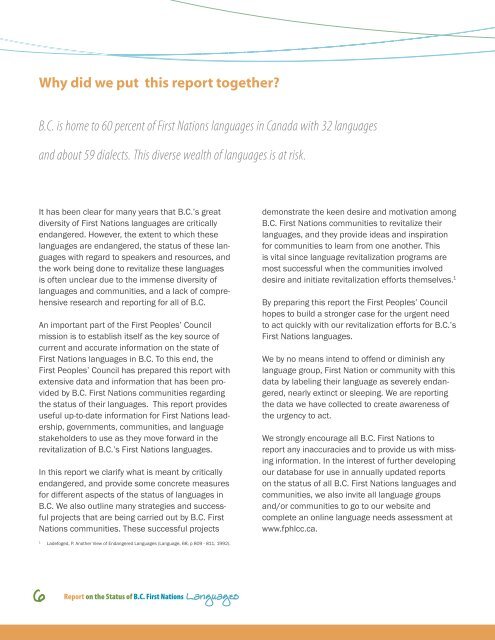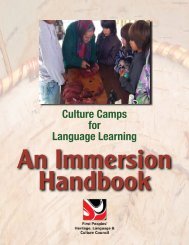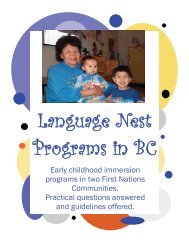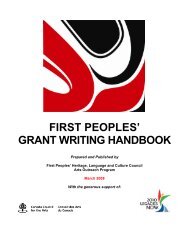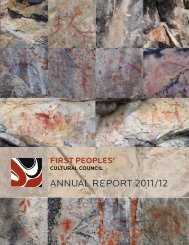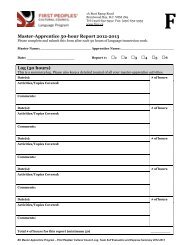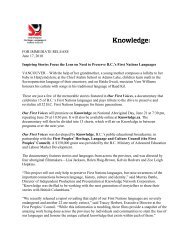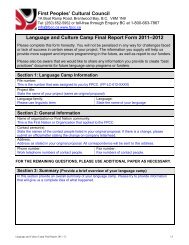What is the status of BC First nations languages? - First Peoples
What is the status of BC First nations languages? - First Peoples
What is the status of BC First nations languages? - First Peoples
You also want an ePaper? Increase the reach of your titles
YUMPU automatically turns print PDFs into web optimized ePapers that Google loves.
Why did we put th<strong>is</strong> report toge<strong>the</strong>r?B.C. <strong>is</strong> home to 60 percent <strong>of</strong> <strong>First</strong> Nations <strong>languages</strong> in Canada with 32 <strong>languages</strong>and about 59 dialects. Th<strong>is</strong> diverse wealth <strong>of</strong> <strong>languages</strong> <strong>is</strong> at r<strong>is</strong>k.It has been clear for many years that B.C.’s greatdiversity <strong>of</strong> <strong>First</strong> Nations <strong>languages</strong> are criticallyendangered. However, <strong>the</strong> extent to which <strong>the</strong>se<strong>languages</strong> are endangered, <strong>the</strong> <strong>status</strong> <strong>of</strong> <strong>the</strong>se <strong>languages</strong>with regard to speakers and resources, and<strong>the</strong> work being done to revitalize <strong>the</strong>se <strong>languages</strong><strong>is</strong> <strong>of</strong>ten unclear due to <strong>the</strong> immense diversity <strong>of</strong><strong>languages</strong> and communities, and a lack <strong>of</strong> comprehensiveresearch and reporting for all <strong>of</strong> B.C.An important part <strong>of</strong> <strong>the</strong> <strong>First</strong> <strong>Peoples</strong>’ Councilm<strong>is</strong>sion <strong>is</strong> to establ<strong>is</strong>h itself as <strong>the</strong> key source <strong>of</strong>current and accurate information on <strong>the</strong> state <strong>of</strong><strong>First</strong> Nations <strong>languages</strong> in B.C. To th<strong>is</strong> end, <strong>the</strong><strong>First</strong> <strong>Peoples</strong>’ Council has prepared th<strong>is</strong> report wi<strong>the</strong>xtensive data and information that has been providedby B.C. <strong>First</strong> Nations communities regarding<strong>the</strong> <strong>status</strong> <strong>of</strong> <strong>the</strong>ir <strong>languages</strong>. Th<strong>is</strong> report providesuseful up-to-date information for <strong>First</strong> Nations leadership,governments, communities, and <strong>languages</strong>takeholders to use as <strong>the</strong>y move forward in <strong>the</strong>revitalization <strong>of</strong> B.C.’s <strong>First</strong> Nations <strong>languages</strong>.In th<strong>is</strong> report we clarify what <strong>is</strong> meant by criticallyendangered, and provide some concrete measuresfor different aspects <strong>of</strong> <strong>the</strong> <strong>status</strong> <strong>of</strong> <strong>languages</strong> inB.C. We also outline many strategies and successfulprojects that are being carried out by B.C. <strong>First</strong>Nations communities. These successful projectsdemonstrate <strong>the</strong> keen desire and motivation amongB.C. <strong>First</strong> Nations communities to revitalize <strong>the</strong>ir<strong>languages</strong>, and <strong>the</strong>y provide ideas and inspirationfor communities to learn from one ano<strong>the</strong>r. Th<strong>is</strong><strong>is</strong> vital since language revitalization programs aremost successful when <strong>the</strong> communities involveddesire and initiate revitalization efforts <strong>the</strong>mselves. 1By preparing th<strong>is</strong> report <strong>the</strong> <strong>First</strong> <strong>Peoples</strong>’ Councilhopes to build a stronger case for <strong>the</strong> urgent needto act quickly with our revitalization efforts for B.C.’s<strong>First</strong> Nations <strong>languages</strong>.We by no means intend to <strong>of</strong>fend or dimin<strong>is</strong>h anylanguage group, <strong>First</strong> Nation or community with th<strong>is</strong>data by labeling <strong>the</strong>ir language as severely endangered,nearly extinct or sleeping. We are reporting<strong>the</strong> data we have collected to create awareness <strong>of</strong><strong>the</strong> urgency to act.We strongly encourage all B.C. <strong>First</strong> Nations toreport any inaccuracies and to provide us with m<strong>is</strong>singinformation. In <strong>the</strong> interest <strong>of</strong> fur<strong>the</strong>r developingour database for use in annually updated reportson <strong>the</strong> <strong>status</strong> <strong>of</strong> all B.C. <strong>First</strong> Nations <strong>languages</strong> andcommunities, we also invite all language groupsand/or communities to go to our website andcomplete an online language needs assessment atwww.fphlcc.ca.1Ladefoged, P. Ano<strong>the</strong>r View <strong>of</strong> Endangered Languages (Language, 68, p 809 - 811, 1992).6Report on <strong>the</strong> Status <strong>of</strong> B.C. <strong>First</strong> Nations Languages


